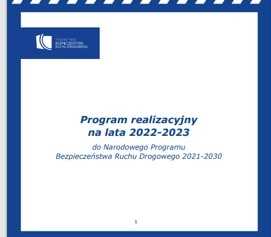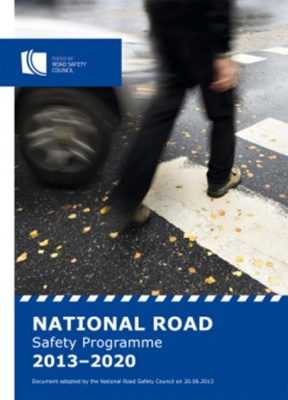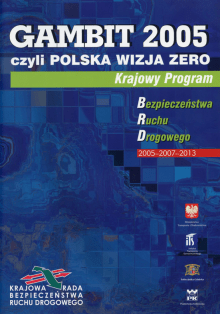

The Action Plan 2022-2023 is the first step plan of the National Road Safety Program 2021-2030 which objective is the number of fatalities not more than 1455 deaths and the number of seriously injured not more than 5317 on Polish roads till 2030. The Action Plan 2022-2023 directly refers to program structure of the strategy with all 5 pillars indicated in the NRSP 2021-2030 (Safe Road users, safe infrastructure, safe vehicle, rescue and post-crash care, road safety management) and its adopted priorities. Action Plan indicates institutions / entities responsible for implementation activities/ tasks according to the main areas of interventions, as well as a time range and a set of indicators showing the degree of its implementation and its estimated impact on the improvement of road safety. Priorities and lines of action for each of the pillars defined in the programme concentrate on engineering, education, and enforcement.
Action Plan 2022-2023 to the National Road Safety Program 2021-2030 includes:
Programme structure of interventions of the National Road Safety Programme 2021-2030 is based on five pillars constituting main areas of activities dedicated to improving road safety until 2030. These are:
Pillar I – Road safety management system
Pillar II – Safe human
Pillar III – Safe roads
Pillar IV – Safe vehicle
Pillar V – Rescue and post-crash care
Priorities and lines of action for each of the pillars defined in the programme concentrate on 3 areas of interventions:
Short-term priorities of the Action Plan 2022-2023 will concentrate on:
The main priority is improving safety of road users with the highest risk of life losing and health (pedestrians and cyclists). There are planned engineering interventions and educational with enforcement on changing behaviours related to road risks. There will be coherent education and communication system on main risk in road safety: driving under influence of alcohol use, no protective equipment, speeding.
Area of interventions of the Action Plan 2022-2023:
| Area of intervention | Number of activities |
| Safe Road User | 11 |
| Safe road/infrastructure | 13 |
| Safe vehicle | 2 |
| Rescue and post -crash care | 4 |
| Road safety management | 5 |
| Total | 35 |
The Action Plan 2022-2023 was elaborated and adopted by key stakeholders of road safety system in Poland. The clear definition and understanding of the key principles allowed adoption of a common approach to the problem of road accidents. The synergy effect was achieved, resulting mutual support of key partners responsible for the implementation of the Action Plan.
More information on Action Plan 2022-2023 – Polish version attached here:
 In 2021 new National Road Safety Programme 2021-2030 was announced which aims to reduce the number of fatalities and seriously injured by 50% in 2030.
In 2021 new National Road Safety Programme 2021-2030 was announced which aims to reduce the number of fatalities and seriously injured by 50% in 2030.
Taking into account the current high level of risk on Polish roads, as well as conditions resulting from the global and European road safety policy, the main objective of the National Road Safety Programme 2021-2030 is to reduce the number of fatalities and seriously injured by 50% within the next decade.
Programme objectives
In 2030 the number of fatalities should not exceed 1455 persons and the number of seriously injured should not be more than 5317 persons on Polish roads. It has to be emphasized that the above estimations are only an intermediate goal established for 2030. The target vision of Polish road safety policy and long-term programs and strategies are to completely eliminate fatalities and serious injuries, which is in line with the far-reaching perspective of European transport policy adopted as part of the Vision Zero implementation by 2050.
According to the Safe System approach, death and serious injury in road collisions are not an inevitable price to be paid for mobility. While collisions will continue to occur, death and serious injury are largely preventable. The Safe System approach aims for more forgiving road system. It accepts that people will make mistakes and argues for a layered combination of measures to prevent people from dying from these mistakes by taking the physics of human vulnerability into account. Better vehicle construction, improved road infrastructure, lower speeds, safer and compliant rod users, better emergency rescue – all have the capacity to reduce the impact of crashes (and if one element fails, another one will compensate to prevent the worst outcome of the crash). This approach involves multi-sectoral and multi-disciplinary action and management by objectives, including timed targets and performance tracking.
Shared responsibility means system designers/ providers are responsible for the safety of the system; all need to play their part in a coordinated manner for improvement of road safety. Public authorities in all sectors relevant for road safety objectives, including transport and infrastructure, environment, education, the police, public health, justice, and tourism need to work together closely at all levels. In addition, all stakeholders have crucial role: industry (including insurance companies), user associations, NGOs, schools, researchers and many more.
The National Road Safety Program 2021-2030 sets 7 principles to be considered at every stage of planning and implementation of activities by decision makers and providers. The principles of the program are: 1. We are limiting the consequences of human’ errors. 2. We design solutions that are friendly to all road users. 3. We improve all elements of the road safety transport system. 4. It is our share responsibility for road safety. 5. We accelerate knowledge transfer, learn from previous experience, promote activities based on modern solution, and best practices 6. Our activities support health prevention and sustainable development. 7. Safety is our high priority.
Programme structure
Structure of interventions of the National Road Safety Programme 2021-2030 is based on five pillars constituting main areas of activities dedicated to improving road safety until 2030. These are:
Pillar I – Road safety management system
Pillar II – Safe human
Pillar III – Safe roads
Pillar IV – Safe vehicle
Pillar V – Rescue and post-crash care
Pillar I: road safety management system. Key point in road safety management is death and serious injury prevention. In focus is all humans make mistakes and crashes are inevitable. Intervention to improve speed management and the road environment all have a major role to play in addressing this new Safe System focus. Road safety management system focus on investments in road design which are self-explaining and encourages safe travel speeds to help avoid errors by road users. To the main priorities in pillar of road safety management belongs:
Pillar II: safe human/safe road use. The priority is safety of road users and promotion of positive road users’ behaviours (driving with speed limits, sober driving, wearing safety belts and helmets). In this pillar first main intervention area is education an alert, compliant and safe road user: young drivers, children, seniors +60, vulnerable road users: pedestrians, motor riders, motorcyclists, bicyclists, wheelchair users. This can be achieved by engineering solutions: traffic calming measures, investments in layout/design of infrastructure that determine road safety’ quality for each group of road users (in urban areas segregation vulnerable road user activity pedestrians, cyclists and motorcyclists from higher speed traffic), implementation of traffic management measures. Priorities are interventions on enforcement on road risky behaviours and delivering coherent education and communication system on risks as: driving under influence of alcohol, distraction, no protective equipment). Education will be specially addressed to senior road users aged 60+.
Pillar III Safe roads and roadsides. Safety infrastructure means predictable and forgiving of human’ mistakes. Safe roads and roadsides are self-explaining their design encourages safe travel speeds and help avoid errors. The main priorities are mitigation of severity of road injuries and development of modern road safety management system. Area of intervention will concentrate on investments in well-designed “forgiving” roads and roadsides and speed management system (road laid out will determine speed of vehicles). The area of interventions will concentrate on engineering solutions to ensure that driving errors will not have serious consequences and they can reduce the severity of accidents (based on injury limitation through a forgiving road environment and anticipation of road user behaviour). The second pilar is development of modern road safety management system (audit of systems, infrastructure, people) and Intelligent Transport Systems. Improvement of speed management system will concentrate on intervention related education of designers and road providers according to the safe speeds. This means travel speeds suit function and level of safety of the road and road users understand and comply with the speed limits and drive to the conditions.
IV Pillar – Safe vehicles prevent crashes and protect in the event of crash road users, including occupants, pedestrians, cyclists. Main priority is engineering improvements in all new and used vehicles according to the setting the minimal technical requirements due to the active and passive safety devices). The second priority in this pillar is improving the system of technical vehicle inspection (optimization of technical, approval and operational requirements in the field of necessary safety devices in vehicles). Enforcement and education is complementary.
V Pillar- Rescue and post-crash care. The goal is to improve rescue and post-crash care to the highest possible standard of rescue operations in the shortest possible time: from the emergency call following a collision resulting in personal injury, and the arrival at the scene of the emergency services.
Main interventions will include improving and developing the medical rescue system, modernizing equipment of road rescue services, as well as developing a system supporting victims of road accidents in the process of rehabilitation and returning to social and professional activity. There are two priorities in this pillar: integration and development of the National Rescue System and deliver uniform support system for accident victims.
Priorities and lines of action
For each of the pillars defined in the programme, priorities and lines of action have been identified, taking into account the main road safety problems and the conditions for their solution.
The activities are planned in a way to include all key areas of interventions:
Programme monitoring
Goals of the National Road Safety Programme 2021-2030 according to the structure of five pillars main areas of interventions: I – Road safety management system; II – Safe human/ safe road use; III – Safe roads/infrastructure; IV – Safe vehicle; V – Rescue and post-crash care will be monitored by basic indicators and Key Performance Indicators.
To basic indicators of goals set in the NRSP 2021-2030 are:
Established and important factors in the Safe System approach are KPIs defined as core elements of safe road use, safe infrastructure, safe vehicles, and better post-crash care. Monitoring the progress of reducing the number of deaths and seriously injured on Polish road till 2030 according to the NRSP 2021-2030 will be asses by 8 Key Performance Indicators:
Implementation Programs
The main tool for implementing the National Program Road Safety 2021-2030 will be Action Plans – an annual or biennial – prepared according to all pillars and oriented towards the adopted priorities. Action Plan will indicate institutions / entities responsible for implementation improvements according to the main areas of interventions, as well as a time range and a set of indicators showing the degree of task implementation and its estimated impact on the improvement of road safety.
Action Plan will include:
Funds for financing road safety interventions adopted in the National Program Road Safety 2021-2030 will come from:
More information can be fouded here:
 In 2013 new National Road Safety Programme 2013-2020 was developed, which aims to reduce the number of fatalities in 2020 by 50% and seriously injured by 40%, in relation to 2010.
In 2013 new National Road Safety Programme 2013-2020 was developed, which aims to reduce the number of fatalities in 2020 by 50% and seriously injured by 40%, in relation to 2010.
 In 1972 the Council of Ministers approved a resolution regarding actions and measures aimed at the improvement of road safety situation in Poland. However, this programme did not prove to be successful and did not bring any positive changes in the situation.
In 1972 the Council of Ministers approved a resolution regarding actions and measures aimed at the improvement of road safety situation in Poland. However, this programme did not prove to be successful and did not bring any positive changes in the situation.Polish Road Safety Observatory
80 Jagiellonska St.
03-301, Warsaw, Poland
tel.: 48 22 43-85-245
© Polish Road Safety Observatory ITS 2024
Motor Transport Institute
80 Jagiellonska St.
03-301, Warsaw, Poland
tel.: 48 22 43-85-400